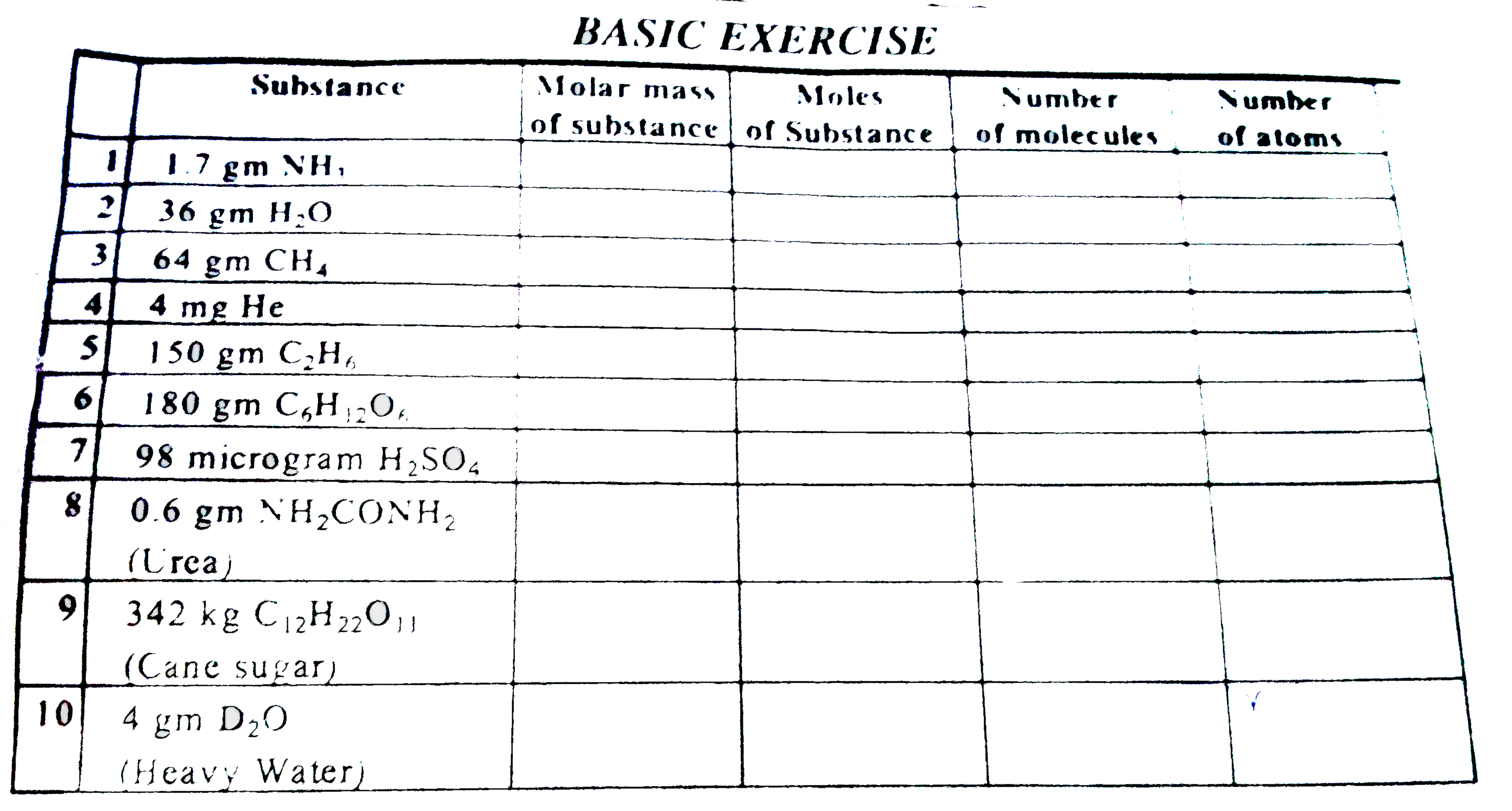Find value of X if 36.6gmBaCl2.XH2O on strong heating loses 5.4g moisture ?
[At mass Ba=137Cl=35.5] .
To find the value of X in the compound BaCl2.XH2O, we need to follow these steps:
Step 1: Determine the Molecular Weight of BaCl2
- The atomic mass of barium (Ba) is 137 g/mol.
- The atomic mass of chlorine (Cl) is 35.5 g/mol, and since there are 2 chlorine atoms in barium chloride, we multiply by 2.
\(
\text{Molecular weight of } BaCl_2 = 137 + (35.5 \times 2) = 137 + 71 = 208 \text{ g/mol}
\)
Step 2: Determine the Weight of Water in the Hydrate
- We are given that the total weight of BaCl2.XH2O is 36.6 g and that it loses 5.4 g of moisture upon heating. This means the weight of water (H2O) in the hydrate is 5.4 g.
Step 3: Set Up the Equation for the Hydrate
- The molecular weight of water (H2O) is 18 g/mol. If X is the number of water molecules, then the total weight of water in the hydrate can be expressed as:
\(
\text{Weight of water} = X \times 18 \text{ g}
\)
Step 4: Relate the Weight of Water to the Total Weight
- From the problem, we know:
\(
X \times 18 = 5.4
\)
Step 5: Solve for X
- Rearranging the equation gives:
\(
X = \frac{5.4}{18}
\)
\(
X = 0.3
\)
Step 6: Calculate the Number of Water Molecules
- Since X represents the number of water molecules, we need to convert this value into a whole number. To find out how many molecules of water correspond to this weight, we can multiply by 10 to eliminate the decimal:
\(
X = 0.3 \times 10 = 3
\)
Conclusion
- Therefore, the value of X is 2, meaning the compound is BaCl2.2H2O.
- The atomic mass of barium (Ba) is 137 g/mol.
- The atomic mass of chlorine (Cl) is 35.5 g/mol, and since there are 2 chlorine atoms in barium chloride, we multiply by 2.
\(
\text{Molecular weight of } BaCl_2 = 137 + (35.5 \times 2) = 137 + 71 = 208 \text{ g/mol}
\)
- We are given that the total weight of BaCl2.XH2O is 36.6 g and that it loses 5.4 g of moisture upon heating. This means the weight of water (H2O) in the hydrate is 5.4 g.
- The molecular weight of water (H2O) is 18 g/mol. If X is the number of water molecules, then the total weight of water in the hydrate can be expressed as:
\(
\text{Weight of water} = X \times 18 \text{ g}
\)
- From the problem, we know:
\(
X \times 18 = 5.4
\)
- Rearranging the equation gives:
\(
X = \frac{5.4}{18}
\)
\(
X = 0.3
\)
- Since X represents the number of water molecules, we need to convert this value into a whole number. To find out how many molecules of water correspond to this weight, we can multiply by 10 to eliminate the decimal:
X = 0.3 \times 10 = 3
\)
- Therefore, the value of X is 2, meaning the compound is BaCl2.2H2O.
Topper's Solved these Questions
- BOOK - ALLENCHAPTER - MOLE CONCEPTEXERCISE - EXERCISE - 0149videos
MOLE CONCEPT
- BOOK - ALLENCHAPTER - MOLE CONCEPTEXERCISE - EXERCISE - 0246videos
MOLE CONCEPT
- BOOK - ALLENCHAPTER - IUPAC NOMENCLATUREEXERCISE - Exercise - 05(B)7videos
IUPAC NOMENCLATURE
- BOOK - ALLENCHAPTER - QUANTUM NUMBER & PERIODIC TABLEEXERCISE - J-ADVANCED EXERCISE24videos
QUANTUM NUMBER & PERIODIC TABLE
Similar Questions

245 gm of KClO3 on heating yielded 64 gm O2.Find % yield of reaction.
(K = 39 , Cl = 35.5 )View SolutionAssuming full decomposition, the volume of CO2 released at STP on heating 9.85 g of BaCO3 (At mass Ba = 137) will be
View SolutionThe amount of BaSO4 formed upon mixing 100mL of 20.8% BaCl2 solution with 50mL of 9.8% H2SO4 solution will be :
(Ba = 137, Cl = 35.5, S = 32, H = 1 and O =16)View SolutionThe crystalline salt Na2SO4.xH2O on heating loses 55.9 % of its weight. The formula of the crystalline salt is
View Solution18.625gKCl is formed due to decomposition of KClO4 in reaction
KClO4(s)→KCl(s)+2O2(g)
Find volume of O2 obtained at STP[Atomic mass K=39Cl=35.5]View SolutionO2 is evolved by heating KClO3 using MnO2 as a catalyst
2KClO3MnO2−−−→2KCl+3O2
Calculate the mass of KClO3 required to produce 6.72 litre of O2 at S.T.P. [atomic masses of K = 39, Cl = 35.5, O = 16).View SolutionCisplatin, an anticancer drug, has the molecular formula Pt(NH3)2Cl2. What is the mass (in gram) of one molecule ? (Atomic masses : Pt=195,H=14,Cl=35.5)
View SolutionA sample of a hydrate of barium chloride weighing 61 g was heated until all the water of hydration is removed. The dried sample weighed 52 g. The formula of the hydrated salt is: (atomic mass, Ba = 137 am u, Cl = 35.5 am u)
View Solution18.625g KCl is formed due to decomposition of KClO4 in reaction
KClO4(s)→KCl(s)+2O2(g)
Find volume of O2 obtained at STP[Atomic mass K = 39 Cl = 35.5]View SolutionAssuming fully decomposed, the volume of CO2 released at STP on heating 9.85 g of BaCO3 (Atomic mass of Ba=137) will be
View Solution

